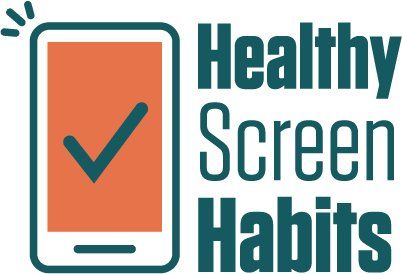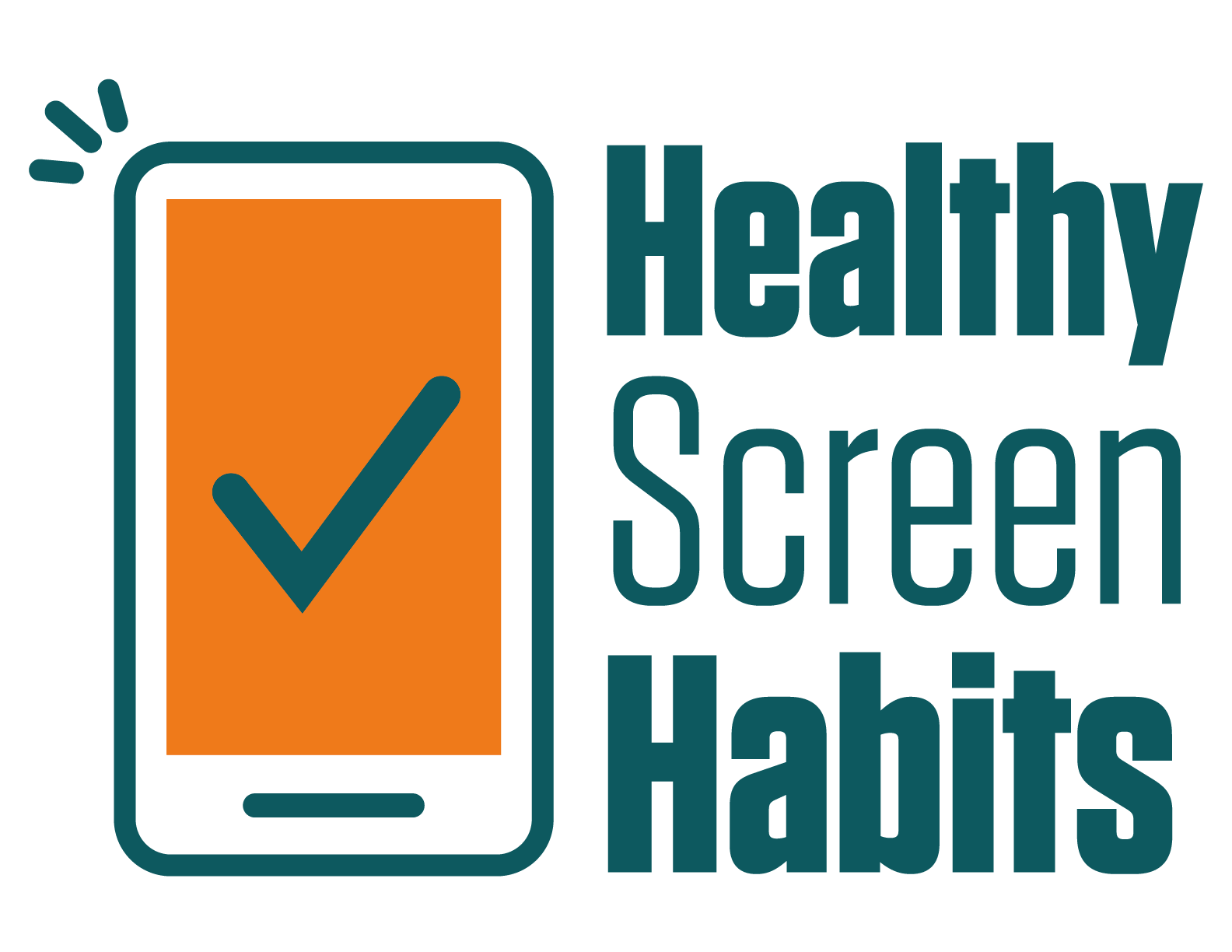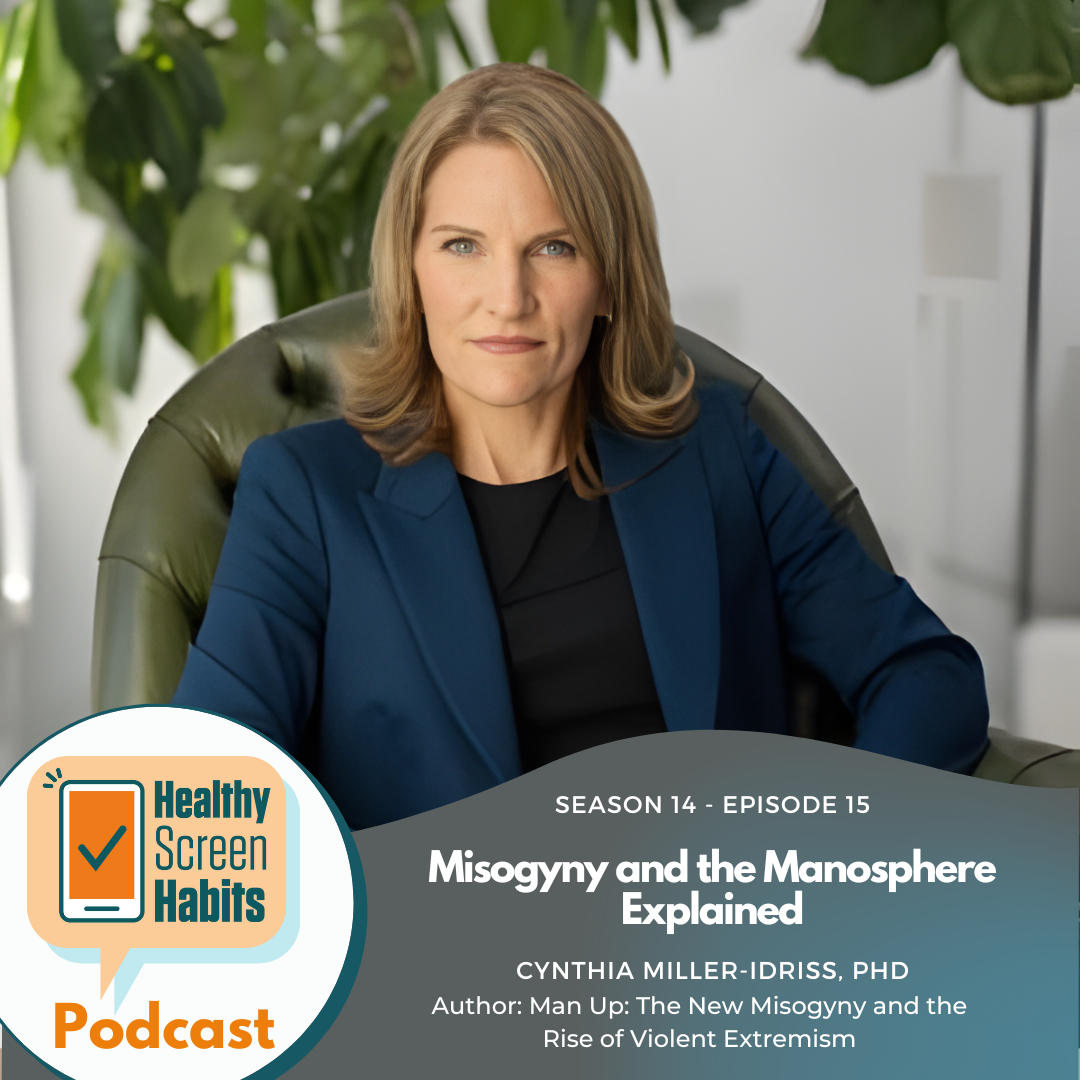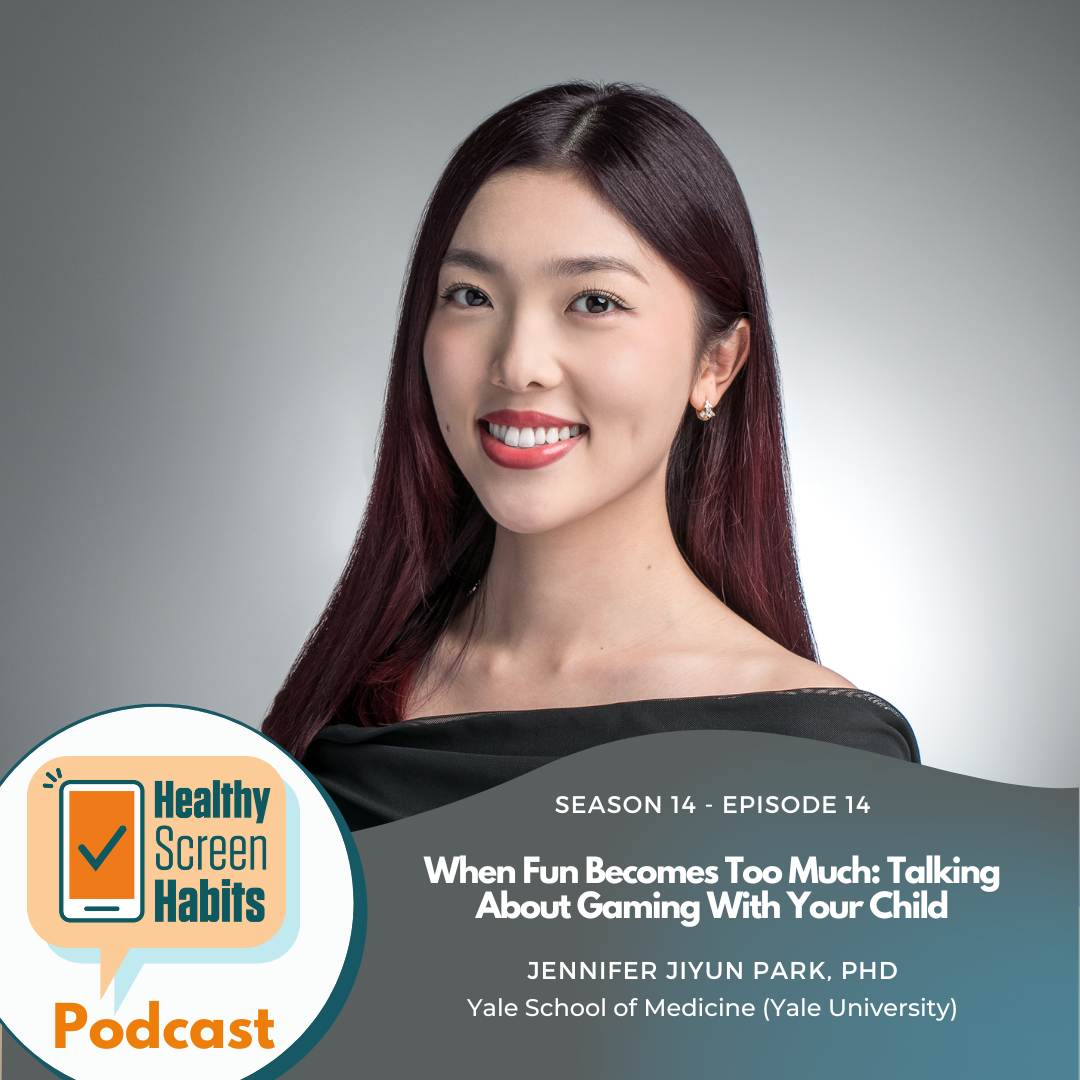S4 Episode 5: Balancing Screentime With Greentime For Good Mental Health // Sandi Schwartz of Ecohappiness Project
Hosted by Hillary Wilkinson
“One of the best bridges from technology to getting kids outside is what's called 'citizen science.' And that's when we (citizens) get involved in a science research project, ... from the government or a local university or a nonprofit organization.”
- Sandi Schwartz
Sandi Schwartz is the founder and director of the Ecohappiness Project, author of the parenting book “Finding Ecohappiness: Fun Nature Activities to Help Your Kids Feel Happier and Calmer,” and journalist specializing in parenting, environmental, and wellness topics. Her mission is to inspire and educate families to build a nature habit to feel happier and calmer. In this episode, we discuss how to create a nature habit and support a healthy balance of screentime and greentime.
Healthy Screen Habit Takeaway
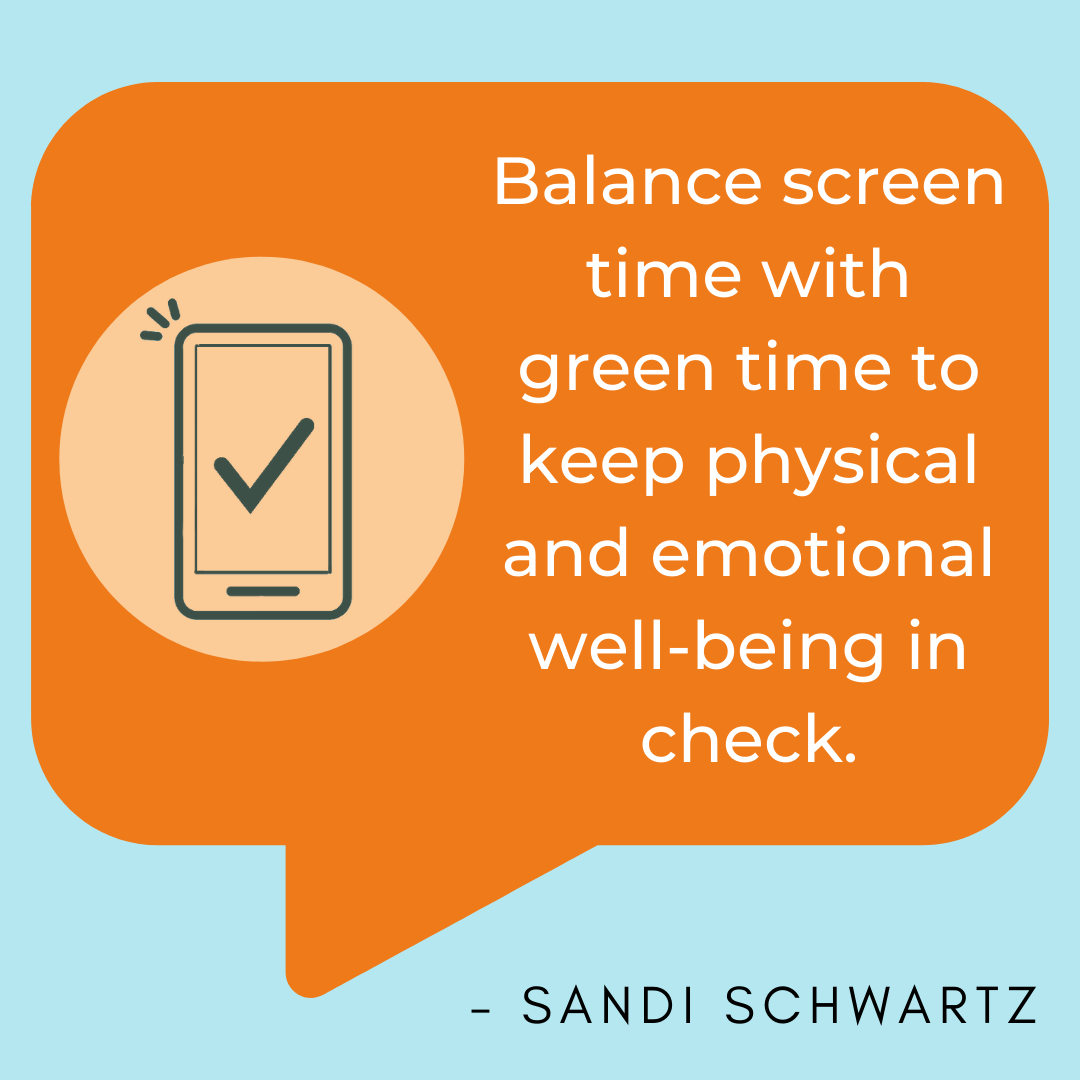
Resources
Last Child in the Woods: Saving Our Children From Nature-Deficit Disorder by Richard Louv
Apps: Calm, Breathe, White Noise, Piku
Show Transcript
Hillary Wilkinson (00:03):
Happy Screen Free Week! As we move through the week with our goals of screen free behavior. I wanted to bring aboard, someone who can tell us about some of the science behind the benefits of what we're doing this week and hopefully spending a lot more time out in nature. And my guest today can absolutely do that. She is the founder and director of the Eco Happiness Project, whose mission is to inspire and educate families, to build a nature habit, to feel happier and calmer.
She began her career at the US Environmental Protection Agency and national academy of sciences after getting a bachelor's in environmental studies from George Washington University, a Masters in government with environmental focus from John Hopkins and a specialization certificate and foundations of positive psychology from the University of Pennsylvania. I'm fascinated to hear more sounds like you are well, well versed in all things eco happiness. And we can't wait to hear from the best, welcome to the healthy screen habits podcast, Sandy Schwartz!
Sandi Schwartz (01:31):
Hi, I'm happy to be here today.
Hillary Wilkinson (01:33):
Great. So Sandy, I'm interested to hear a little bit kind of about your background. You've got this great mixture of natural science and psychology, and somehow it's like bleeding into this digital wellness arena as well. And just tell us everything. How did you get started in digital wellness and what was your motivation behind founding Eco Happiness?
Sandi Schwartz (02:01):
Sure. So I wanted to save the world and then I realized, uh, nature can save us as well. That's so it goes hand in hand. We need to do the work so it can help us. So basically, um, it goes back to my high school days when I cleaned up a dirty river in my hometown in New Jersey. And I was part of the Nature Defense Club, and that really sparked a passion in me to focus on the environment. And I went on to study environmental studies in college. I, uh, went on in graduate school to focus on environmental policy and government. I thought it was gonna be an environmental lawyer to be honest. And that, um, it's interesting how life kind of takes you on different, you know, turns, shifts and turns. And I ended up more in the realm of communications and science communications, and I did a lot of that at the EPA and then at the National Academy of Sciences.
Sandi Schwartz (02:58):
And my main, you know, focus is to, uh, educate people about the public understanding of science. So we can tell them that nature is good for them, but I wanted to give them the reasons why, and to really, uh, highlight the science because a lot of times people need that evidence and they need, you know, years of evidence to, to do that. Kind of like when you think about mindfulness as a, as one other example, uh, of a realm that we now know to integrate it into our, our health and happiness world and more and more people are, you know, engaged in yoga and meditation because the science is backing it up. Even though it's been around for thousands of years, around the world, we now know that it helps us. So that's the same, uh, same way with, with nature. So basically I was studying all about the environment, environmental protection, but I was also personally struggling with stress and anxiety.
Sandi Schwartz (03:53):
And when I look back at my whole, you know, my, it was in my childhood with sweaty palms in the math class and, uh, nausea before school to, uh, chest pains in college when I wasn't doing so well, uh, in one, in one of my first classes first semester. And then it really kind of came to a big trigger, was dealing with infertility and, uh, preterm labor with my first child. So I also, after he was born, I, you know, I'm a very “Type A” kind of person. So I wanted to be the mom that did everything perfect, everything right. And I just was too revved up, you know, the adrenaline, the cortisol was pumping through and I really was experiencing what I now know as postpartum anxiety. So, so all this was kind of coming together, my interests and love for this saving the planet and then my own personal struggles. And I then started on this path of research about positive psychology and that's aspects like mindfulness, gratitude, practice, um, engaging in nature and awe and really, you know, these, these ways, these positive ways to make our lives better. So that's where I ended up saying, “Hey, you know, I can save nature and it can save me too!”
Hillary Wilkinson (05:12):
Wow, that's a, a beautiful marriage of all things. It sounds like it was a, a struggle to get to the place that you are. And I, I'm sorry for your struggle, but I admire that you've taken that struggle and used it to create something so positive for the rest of us. So as you know, I'm, I'm all about the healthy habit building and the mission of, um, the Eco Happiness Project is really kind of what captured me. The mission is to inspire and educate families, to build a nature habit, to feel happier and calmer. So my eyes just lit up when I read this and I've never heard of a nature habit. What is this thing? And you've talked a bit about why it's important, but like what, what, how do you define this nature habit?
Sandi Schwartz (06:09):
Well, it's something that we've lost in this current generation, about 20 or so years ago, Richard Lou wrote a book about nature deficit disorder, and he's kind of my, one of my inspirations to have gone down this, this research, um, path. And, you know, he found that kids just weren't spending enough time outdoors, and this was causing physical and emotional issues. And this has only gotten worse with screen time.
Hillary Wilkinson (06:39):
And I'm sure skyrocketed with the pandemic as well.
Sandi Schwartz (06:43):
Yeah. So like any other healthy habit like meditation, or, um, cutting back sugar, caffeine, or exercise, having nature in your life, in your daily routine. And it can be something so simple as stopping to look out the window, right? Like taking a break from your computer screen and turning and looking at the window and really engaging mindfully in what you're seeing. I mean, out my window, I have beautiful palm trees I'm looking at and the colors and, and to say, well, it's not just green. I see gold. And I see yellow and I see brown and I see orange. And so it's really encouraging people to stop and smell the roses and to take what they're doing every day anyway and see how they can incorporate nature into it a little bit more. It can also be something as simple as when you're taking your kids to school on that drive. You know, what are you really seeing on that drive? Do you even remember, you know, the bushes, the trees, the flowers, instead of just looking at the buildings, what about looking at the clouds too? Maybe there are birds flying that you're missing when you're at the red light. So that's what it's about; kind of taking, you know, assessing your, your life and bringing a little bit more nature into it.
Hillary Wilkinson (07:59):
Sounds like just bringing a lot of intention towards noticing nature.
Sandi Schwartz (08:06):
Yes, and that's the first step, uh, you know, you can then go on and on and say, well, we're going to eat one dinner outside a week as a family, we're going to sit down and, and find, uh, you know, write on a list of activities we want to do every weekend that involves discovering nature at our local parks or science museums heading to the beach or the lake, the mountains, whatever it may be. And then to me, the habit, you start small, you start with what you're already doing and keep expanding it and, and find out what you love. And next thing you know, you'll have a new hobby.
Hillary Wilkinson (08:41):
Yeah, yeah, for sure. When do you recommend parents start doing these things?
Sandi Schwartz (08:50):
Oh, from the minute they're born, one of the best things you can do. I actually, a few years ago, I wrote a blog post about, um, body wearing and then taking your child outside on a walk while you're wearing them, you know? And so it, um, or in a stroller and from a very young age, it helps develop even something as simple as their vision, so they can get like that whole, the dimensionality of, of being outside versus just staring at a wall or screen and the colors. And, and it, the, the thing about nature, that's so powerful is it engages all of our senses. And so a young child as they’re developing, I mean, and every day and every week and every month of young child's development is so critical. So the more time that they can be really observing and looking and pointing to the sky and you know, it, it really can expand their, how they develop.
Hillary Wilkinson (09:43):
Right. And I, I kind of wanna tease apart. You, you mentioned a word that I've, I've seen a lot used in nature studies and that's this word. Awe. Can you talk about that a little bit?
Sandi Schwartz (09:58):
Yes. I'm in awe of awe. It was so fun to dive into the research on awe because it's new and it's still developing. And it is this emotion that is very hard to describe. It's magical. It's, it's that feeling when you have chills up your spine and tears come to your eyes. And so it could be like when you're looking at the stars at night and you're just fascinated by how big is the universe, or it could be music, you know, if you're listening to an orchestra that can be awe. And so, you know, I of course focus on the awe of nature and know one of my big awe moments was standing at, at the Grand Canyon when I was a kid. You know, I'll never forget that moment. And actually recently I didn't realize my husband's never been there. And my kids were asking about it. I'm like, well, we have to go back there. It's like one of my favorite places in the world to, to stand or, oh, on my honeymoon, we took a daring helicopter ride, which I was so afraid of, but I saw the most incredible visions, you know, out there flying above Hawaii. And so that was awe.
Hillary Wilkinson (11:07):
Right.
Sandi Schwartz (11:08):
So it is a, there's a whole book I actually reference in my book, um, cause there's not a lot of, of, um, material on off. So, so I, I highly recommend it's all, Awestruck, I believe is the name of it. Anyway. Uh, it's also on my website, but it dives into the, the specifics of awe. And I have a few blog posts I've written about, you know, how you can incorporate awe activities into your family's routine and, and vacations are definitely the way to go for sure.
Hillary Wilkinson (11:38):
Neat. Okay. We have to take a break, but when we come back, I'm going to ask Sandy Schwartz, the best ways to get our kids out into nature. Do you have any questions for me?
—---------Ad Break —---HSH Bookclub—----------
Hillary Wilkinson:
My guest today is Sandy Schwartz, founder of the eco happiness project, an author of finding eco happiness, fun nature activities to help your kids feel happier and calmer. So Sandy, I would imagine that exploring the activities to include in your book was a lot of fun and probably reflective of your own life. You've mentioned a little bit of your family life. Do you have children?
Sandi Schwartz (12:47):
Oh, sure. Of course. And, and actually the re another big reason I wrote this book is, you know, it's a book I wish my parents had for me. And it was something I felt like I needed to do for my children and all children and future generations. So yes, I have a nine year old daughter and a 13 year old son.
Hillary Wilkinson (13:04):
Oh, fun. You're in, you're in the middle of it.
Sandi Schwartz (13:07):
Yes. Oh yeah. This is easy though. They, they like to make their own breakfast and, and lunch and they're very independent, so lot easier than those early days when I was having all that anxiety that's for sure. Yeah.
Hillary Wilkinson (13:20):
On your website, ecohappiness.com, you have this, um, Nature Habit Quiz. And can you explain what this is and why it's important to understand maybe the types of nature lovers that you have in your own family?
Sandi Schwartz (13:38):
Yes. So a lot of parents want to know how they're going to integrate nature into their lives and build a habit because it seems like more work. And I say, start with what you already love. Start with what your children already love, what you're already doing and then springboard from there. And so this quiz helps categorize kids into five different areas. Uh, it's a 10, 10 cute little questions, things about, you know, what is your child's favorite afterschool activity? What's their favorite birthday party theme. And then you'll get an email categorizing them in either a creative art, green exercise, animals and citizen science, travel and adventure, or mindfulness and meditation. So depending on how they answer these questions and you can do this for all your, each of your children, you can do it for yourself, which is fun too. And then you'll get this list of suggested ideas based on their current interests. So, um, you know, a child who can't sit still and is very curious and loves to run around, they're going to love adventure. They're going to want to go hiking and biking and paddle boarding and canoeing. And so it's great to start there again with what their interests are and what they love. So that when you say, Hey, I want to let's get outside. They're not going to say, “No, I want to play Minecraft instead.” Cause you know, they, they're going to be looking forward to these activities that they already enjoy.
Hillary Wilkinson (15:09):
Right. And I kind of love how this is a, um, what a technique that we call bridging from technology to the outdoor world. So if you involve your child in this sort of questionnaire on asking them, well, what do you think? What kind of, like you said, what type of birthday party would you have or what, how do you enjoy spending time after school? Then they're going to have more buy-in to the results. And then you can say, oh, and look at what this is directing us to do. So that's a very cool way to marry technology with outside. So, um, do you have like techniques, tools that are in your, uh, you know, your bag of tricks that, that we can help make other connections to nature like good websites or anything along those lines?
Sandi Schwartz (16:05):
Well, what's, what's been really interesting is the way I broke it up, you know, so it allowed me to dig into each of these areas. And so for example, creativity alone, when you merge creative arts and nature, there are so many opportunities out there to engage in nature. And this can be anything from a child who loves music. They could write, maybe they play the piano and they have a song that they're practicing. They could add their own lyrics that have to do with a nature story, right. And then that gets them into it. If you have a someone, a child who loves to, to draw, you know, sit them outside in the backyard and, and challenge them to draw the nature scene as opposed to maybe cartoons inside. And so there there's just so many opportunities and ways to, you know, start with again, with what they love, but also challenge them to the next level.
Sandi Schwartz (16:59):
And I do think technology plays a role in, especially the mindfulness realm, the creativity realm, and even this child who's interested in science. So some resources of course are, um, if your child, your example is having trouble sleeping, uh, there's wonderful apps out there that allow them to listen to nature sounds because nature sounds have been proven, you know, like bird song and ocean waves and, and rainfall, that's all been proven to reduce cortisol and to help us feel calmer. And so some of my favorites include the app: Calm, the app: Breathe. And I also have one called White Noise. And this was actually very helpful to me when I was, um, temporary living in a place with a very loud train that would go by. So I would put on, you know, the, the rushing water sounds or the, a fire, um, sounds of a fire. It was like, um, uh, it was wonderful. And I just think that they can play around with it and you can actually add more than one sound to the mix. So it's kind of, it's interesting. Yeah. And then also, um, full disclosure, I never used this app, but I've read a lot of good things about Piku, P I K U calm kids app. And it has all kinds of guided meditation specifically for kids and not all our nature related, but some are of course. Oh, so those are great resources.
Hillary Wilkinson (18:21):
Yeah. I knew you were the right person to ask, which seems, it seems ironic to be asking for are websites during screen free week, but I kind of want to, you know, project going forward. I feel like these are tools that people can use even when we're not doing this, you know, lockdown of tech.
Sandi Schwartz (18:42):
Yeah. And the other thing, I think the, one of the best bridges from technology to getting kids outside is what's called citizen science. And that's when we get involved in a science research project, um, from the government or a local university or a nonprofit organization. And for example, iNaturalist is a very popular one now and you can get on there. So an example would be they ask you to go out and count the birds that you see within, you know, in your backyard and to take pictures and to indicate what they are. And so all of that data then goes into a bigger system and so children can play a big role in science. And it really does, even though they're using tech, they're still outdoors.
Hillary Wilkinson (19:29):
Yes. And I love how so many great things stem off of this one. I'm, I'm kind of further down the parenting path with than you are. I have older teens. And so, you know, you're looking at this point, you're looking for possible majors in college or life path type stuff. And you do want to have a very well rounded approach to what you've experienced and what your passion is at that point. But also, um, we're in a migratory path for Monarch butterflies here. And so occasionally you find a tagged Monarch butterfly, you know, and so being able to go in and log log in the, uh, the numbers on that is always, that's, that's a big thing as well. So I totally agree with you with the citizen science. It becomes very much like a treasure hunt getting the kids out in nature and seeing what they can count or see or do.
Sandi Schwartz (20:37):
And a lot of the older kids have violent community service hour requirements. So that's another great way to, to tackle that right
Hillary Wilkinson (20:44):
On your website, you have this awesome graphic that I really liked. Um, it, it's a calendar and it's called the 30 day eco happiness challenge. And are some of the things that you rec that you talked about earlier? I was thinking, oh, like the eating outside and stuff like that. Are there any other things you can just talk about and recommend how parents could implement a few of those?
Sandi Schwartz (21:11):
Of course. And I want to just tell you how this came about when the pandemic started. I said to myself, how am I going to get through this? What can I do to use positive psychology, you know, to keep my sanity. And so I challenged myself to go 100 days of doing one nature activity each day. And so this 30 day calendar stemmed from that experience, it was fabulous. And, and I highly recommend everyone challenge themselves. So other ideas would be taking nature photos, keeping a nature journal, painting, or drawing a nature scene, the visiting a scenic place virtually, that's a good one! Another way to merge tech and nature, they have like wildlife cams around the world where you can actually be under the ocean and see, you know, all the marine life. They also have them where you can watch an Eagles nest.
Sandi Schwartz (22:09):
So it's pretty cool. And that's a great way to, to engage children, practicing outdoor yoga, simply watching the clouds. One time, my daughter, and I just went to a spot for about 30 minutes. We had a little journal with us and we each just stared at the clouds and drew pictures of what we saw, cuz it's amazing what you can see in the clouds. And then it moves and changes. So, um, yeah, there's so many, so many options and for people to engage in and I hope that they'll head over to ecohappinessproject.com and grab, grab that to challenge themselves and their families. Yeah.
Hillary Wilkinson (22:46):
I love it. Okay. So we have to take a short break, but when we come back, I'm going to ask Sandy Schwartz for her healthy screen habit.
—----Ad Break—-Thank you to donors—-------------
My guest today is Sandy Schwartz, founder of the Eco Happiness Project and a person who is passionate about getting people outside. Now on every episode of the podcast, I ask each guest for a healthy screen habit, which is a tip or takeaway that people can put into place in their own lives. And I'm wondering Sandy, if you have one?
Sandi Schwartz (23:46):
I sure do. So my tip is to balance screen time with green time to keep both physical and emotional wellbeing in check.
Hillary Wilkinson (23:57):
Love the rhyme scheme: balance screen time with green time! And I know let's to just briefly you had, um, mentioned earlier with me something about a green hour?
Sandi Schwartz (24:12):
Yeah. So this idea of screen time and green time, you can actually use that to negotiate with your children as well. So, you know, Hey, play outside for an hour and then you can get your screen time. So if this is something you're struggling with, uh, with the kids on the screens too much, you can weave in the green time as that bonus. And you know, I want to go to the, the, the struggle and, and, you know, point of having to track it all. Um, I know like some people have all that, you know, you can only be on your screen certain number times, you know, they have those apps or whatever, but I think that would get a little too intense. You know, you want kids to start increasing their own green time naturally by doing what they love.
Hillary Wilkinson (24:59):
Maybe even just I'm - in my house, I'm just thinking we have with after school activities, these things get really compressed. So maybe it's a screen day with a green day. So it's like maybe, you know, Tuesday, Thursdays are tech days. They both start with “t”. So, you know, but then Monday, Wednesday, Friday might be green days. So, and then I can, I'm, I'm just going and going with this cuz then the dinnertime conversation is going to be really interesting to talk about how does your body feel? How, how do you feel about after having spent time online or on a game or something like that, a virtual game versus an outdoor experience? So I think nothing beats experiential learning and is, so if you can, if you can weave that in and that's a wonderful habit!
Sandi Schwartz (25:55):
And also just really teaching your kids and you know, this is important for us too, to step away from the screen, you know, set the alarm every 30 to 60 minutes and go look out the window, go take a quick five to 10 minute walk outside, eat your lunch outside. You know, whether in your office or your home, that's what it's about because it, again, it's all about balancing and having those breaks and it just helps us so much. It'll make you, uh, be able to concentrate better. It'll allow you to be more creative, because that's what nature does.
Hillary Wilkinson (26:30):
Right? Right. It's where we were literally built to be.
Sandi Schwartz (26:34):
Yes, indeed.
Hillary Wilkinson (26:36):
Oh, well I love how your habit addresses the whole person, physical and mental or physical and emotional wellbeing. So as always, I will link all of your information plus the, um, the websites that you gave, the websites and apps that you gave us tips on in the show notes and Sandy, I cannot thank you enough for being here today and sharing with us your knowledge of the outdoors!
Sandi Schwartz (27:07):
Thank you so much. It's been great. And I wish everybody all the eco happiness in the world!
Hillary Wilkinson (27:12):
Yes. And uh, and much success on their screen free week!
Sandi Schwartz (27:15):
Yes.
About the podcast host, Hillary Wilkinson
Hillary found the need to take a big look at technology when her children began asking for their own devices. Quickly overwhelmed, she found that the hard and fast rules in other areas of life became difficult to uphold in the digital world. As a teacher and a mom of 2 teens, Hillary believes the key to healthy screen habits lies in empowering our kids through education and awareness.
Parenting is hard. Technology can make it tricky. Hillary uses this podcast to help bring these areas together to help all families create healthy screen habits.
